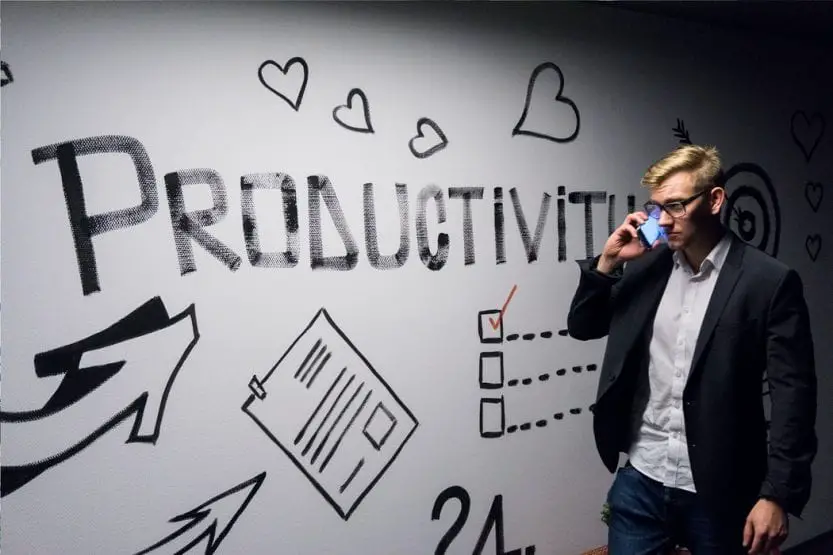Productivity is considered an essential skill for businesses. Only when employees are working at their full potential, can they deliver real results. But productivity is also something most people struggle with. The consistency and dedication that regular productivity requires needs to be paired up with a lifestyle that can sustain it.
One way to create a lifestyle that encourages productivity is by changing the workspace visually. Color theory lends itself to the idea that people react to colors in certain ways. Red represents passion, green represents a natural calm, and blue represents, among other things, tranquility. Things that are blue can make a person feel more inspired to work, but how?
How does color increase productivity?
At any time, people react to the environment they are placed in. When they’re at work, the workplace should represent an environment that encourages productivity. According to research done by the University of Texas, the color blue could have an important role in increasing workspace productivity. The researchers compared what happens when people work in a red and white environment, against a green and blue environment. The results showed people worked better when their surroundings were green and blue.
The association of green with productivity was already known. Green is a calming color that relaxes the eyes. This is the reason behind why many blackboards in school were colored green. It was believed that children would be able to look at the green blackboard without straining their eyes. In that way, the green color would calm their eyes and help them while learning.
When it comes to the workplace, blue gains this same importance. Blue is also a color that is associated with trust and reliability. Using blue around the office also helps people collaborate better.
Blue and Color Psychology
Angela Wright is a color psychologist who is best known for building the Color Affects System. She associates colors and how people perceive them, linking personality types to colors as well. She believes that the color blue has a role to play in inspiring intellectual thought in people.
Traditionally, blue has been associated with everything from the natural elements to sadness and melancholy. Blue is also related to peace and tranquility. The use of the intellect comes in tandem with the peace and tranquil nature that blue promotes. When the mind is at peace, people are better able to focus on getting their work done.
The colors blue stimulates the mind and calms it down at the same time. This is the ideal combination that anyone who wants to increase their productivity should take advantage of. Things that are blue such as curtains, stationary, chairs, and even coffee mugs at office can work to increase productivity and professionalism.
Why is blue better than other colors when it comes to productivity?
People tend to react to colors differently. As a population, people find that certain colors invoke specific emotions and thought patterns. The color red has most commonly been associated with love, passion, ambition, and even anger. However, the color red is not that commonly associated with sadness or the color of the ocean.
In the same way that red inspires certain behavior within people, blue inspires different behavior patterns. If you want to make sure that your workspace has been designed to boost productivity as much as possible, then use blue color in your floor design. A study conducted by the University of British Columbia showed that blue is the color associated with increased productivity. The same study also showed that the color red invokes different responses in people when it comes to work. The color red makes people pay more attention to details, while blue is better suited to improving productivity.
There is a reason behind this. Blue is a color that does not bring out any strong responses from people. A calm and neutral color, blue energizes the mind while also making it feel calm. Together, these qualities boost productivity by allowing the person to solely focus on their work without distractions.
Which shade of blue is the best for productivity?
There’s no specific shade that boosts creativity more than others, but different shades of blue do bring about different reactions from people. Darker blues are evocative of professionalism, austerity, success. Lighter blues evoke thoughts of collaboration, genial behavior, and work ethics.
That is why corporate suits tend to be dark blue in color. When you’re approaching a client or in charge of your employees, you want to look professional and dependable at all times. The color blue can help you achieve this. A client meeting where you’re wearing a blue suit can go much better than one where you’re wearing a brown or a gray suit.
Other things that are bluethat make life at work easier can include anything from notebooks to pens. Will there be a change if you shift to using blue pens at work instead of black pens? Color psychology suggests that yes, blue pens can increase productivity among employees. Even more things that are blue that you could install around the work environment include decorations, fixtures, and even the walls. People find the color blue pleasing. It’s also the most well-liked color in the world. Aside from boosting productivity at work, the color blue is also a color people visibly enjoy.
What does productivity have to do with the color blue?
Blue has inspired many different responses and ideas from people throughout history. Productivity is one of them. Blue is also known to make people feel more serene, at peace with themselves, and relaxed. At the same time, blue is also associated with negative emotions, such as depression and sadness.
People have always considered blue to be important, but its links to productivity in the workplace are due to more recent research. One of these came from Santa Cruz’s University of California. Here, researchers tried to study how the color blue affects productivity in mice. Mice have a very similar way of visually experiencing the world as people. This holds even more true for how the sky looks during dawn and dusk. In these twilight hours, the colors blue and yellow playfully dance and create beautiful visuals in the sky.
Like humans, the mice too enjoy this change. The researchers studied mice at 24 hours periods and discovered that the blue light that emerges during twilight has a direct effect on how productive the mice are later. As nocturnal creatures, the mice begin their nightly routines only when the blue light during dusk informs them to. If humans are similar to mice in how they see the world, then this link between the color blue and productivity could also be seen among people.

Does color have an effect on mood?
Color psychology suggests that color and mood are directly linked. It says that certain colors are related to certain emotions and experiences more than others. And over time, people may have adapted to these relationships between color and mood.
In society, important festivals and rites are related to color. Mourning colors are different from wedding colors. A red rose is always related to love, while a yellow rose indicates friendship. As popular ideas, these have spread around the world. Today, people automatically associate certain colors with certain moods. In a way, the colors can be thought of as symbolic representations of certain moods and feelings.
Blue too had been associated with certain moods and feelings. While some of these tend to be negative, such as feeling down, sad and lonely, other indications are more positive. Blue is a professional color, and when people see it, they tend to associate it with reliability. Blue is also related to loyalty, which is an important feeling to establish in the workspace. A 2003 study released by the Journal of Business Research revealed that customers were more likely to visit and purchase items from a shop that had walls painted blue.
At work, the color blue can make people feel happy about being in a certain room. The right blend of things that are blueat work can make a happy and productive workforce.
The color blue and productivity
When it comes to productivity, blue is most closely associated with getting things done in the office. The calming and stimulating effect of the color blue inspires the right approach at work. At the same time, there are many light and bright shades within the blue color palette that invoke positive emotions.
Blue increases productivity by making the environment more conducive for people to work in. That people react to colors has already bee established. Blue, in particular, is associated with professional success and the business world in contemporary society. People tend to be more productive when they are in an environment that has been color blue. An office designed and accessorized by things that are blue can also have similar productive effects on people. Whether you’re at work, studying for exams at home, or learning a new skill, having things that are blue by your side can give you an edge when it comes to productivity.



